Editor’s note: Michael Lieberman is founder and president of Multivariate Solutions, a statistical and market research consulting firm.
Brand equity is one of the more popular concepts in marketing today. It is also one of the most overused and misused terms in marketing research and the subject of much “fuzzy” thinking. In fact, there are several definitions of brand equity, all of which stem from the concept of “brand.”
A brand is the sum total of all that is known, thought, felt and perceived about your company, service or product. Branding, then, is the process of making products and companies into brands - the consistent and disciplined way a company communicates a brand’s essence to the public (according to Martin Thoma of Thoma Thoma Creative). Consumers’ response to the brand revolves around the brand’s image. This makes the concept an essential input into marketing strategy since a positive, strong brand image will lead presumably to higher sales. In addition, it is known that image drives brand equity.
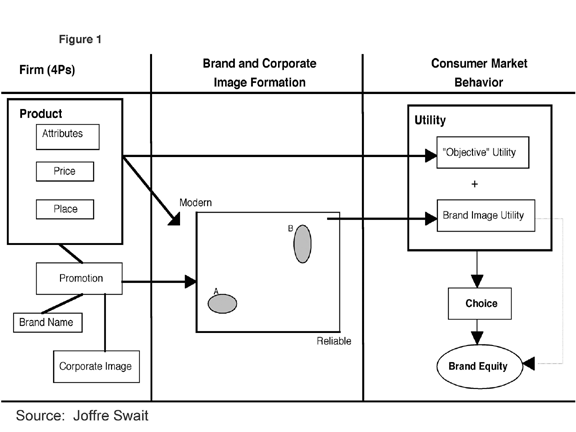 |
Brand equity is a way to describe a brand and measure its total value. Brand equity can be illustrated by a hierarchy (Figure 1) incorporating the four Ps (product, price, place, and promotion [advertising]) of marketing.
The crucial point of this framework is that brand equity only exists as a function of consumer choice. It comes when the consumer chooses a product. The characteristics of the product are evaluated and then they are translated into “objective” utility, the value the consumer places on the brand. The communication efforts of the company to market its brand contribute to building brand image (e.g., consumer confidence in the brand due to quality perceptions, price, etc.). But how much is brand image worth? An effective way to place a dollar value on brand equity is by using a discrete choice model.
How is brand equity measured?
There are a number of approaches to measuring brand equity that are useful to brand managers. In the brand hierarchy model in Figure 1, equity is the public perception of brand loyalty. Obviously, building loyalty is the goal and mission of advertising and public relations efforts, which arise out of brand strategy development, which is a conscious effort to create a brand “culture” and thus a brand identity. An example of this is shown in Figure 2, which we call a brand image chart.
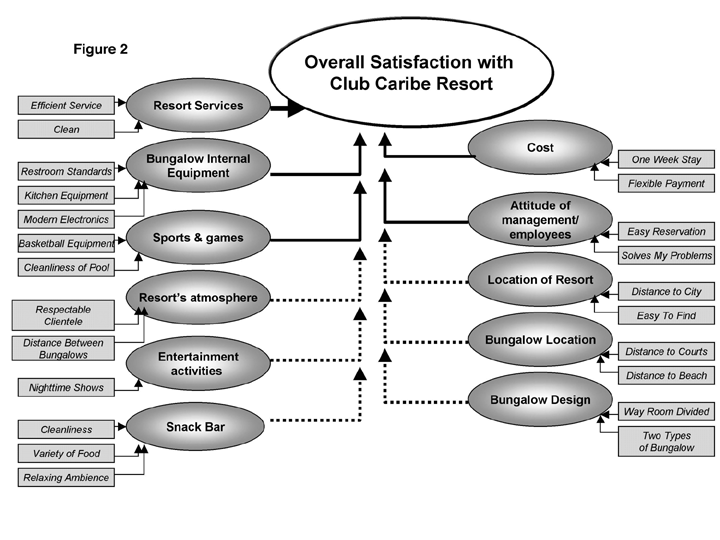 |
It shows a key association regression of the service elements that contribute to overall customer satisfaction with Club Caribe, a fictional resort that wanted to measure its brand equity for communications purposes. The solid lines display the significant factors that contribute to the brand equity of Club Caribe, which are its services, prices, bungalows, management, and sports offerings. The secondary level - the sub-attributes - are what drives the main service elements of the resorts.
This measure of brand equity is not a dollar function, but rather one which illustrates the service elements that can best be used to promote Club Caribe. The theory is that the significant club services explain the primary motivators of why guests visit Club Caribe, and what makes them happy during their stay.
Another approach is to measure the dollar value of the brand’s objective utility. In other words, how much are customers willing to pay for that brand? Years ago the company where I was employed attempted to develop a brand equity model that could be then sold off-the-shelf to clients as a “product.” As I recall, the idea of brand equity was the additional money people were willing to spend on a branded product over the exact generic product. The problem with the model was that it required a generic price to be established. The author of an article on the subject suggested a panel of experts should be asked to set the generic price. Of course, on a by-project basis that was not a feasible solution.
There is a better way: choice modeling.
Discrete choice models - the basics
Discrete choice analysis consists of a series of questions that ask respondents to choose between two or more hypothetical products or services. These models operate under the assumption that demand is the result of several decisions of each individual in the population under consideration.
Discrete choice analysis is used to simplify a description of reality and to provide a better understanding of how consumers make product decisions. The model can predict future states of the market, show where the market’s behavior can be influenced, and indicate how a product’s performance in the market can be optimized.
A discrete choice model uses a multinomial logitistic regression technique that produces coefficients for each level of service and, in turn, likelihood percentages to estimate market share or choice probabilities. The model yields exponential utility scores that can be used to produce the desired output - in other words, optimal pricing, market share, and brand equity measurements.
A spreadsheet is set up with the output from the model whose values from the regression results are identified. A series of trials is then generated, each one of which represents different versions of the product. Choice probabilities are calculated to fit a given choice scenario, or can be easily adjusted to construct a market share forecast.
The strengths of a well-constructed discrete choice model are that it:
- allows for multiple what-if scenarios within the context of the model;
- can be used easily to optimize price or brand positions within existing market realities;
- takes into account the “non-purchase” by a customer;
- gives customers real-world choice since competitive brands are included, and they can have different prices;
- can target specific competitors, if desired, with products designed to take share specifically from them.
The discrete choice segment of the survey instrument would contain a question like the following:
Please choose from one of the following mouthwash brands:
1) Scope brand at $2.49
2) Listerine brand at $2.49
3) Plax brand at $1.99
4) Generic brand at $1.49
5) None of the above
A respondent might rate nine of these scenarios, each with the price levels changing, though the numbers vary according to the number of brands and/or other factors that might be included.
This is not a technical article; nevertheless, a basic understanding of how the market share is calculated is necessary. Probabilities for an individual brand and a particular price point are the quotient of its output - utility scores - divided by the utilities of all brands in the equation or included in the simulation.
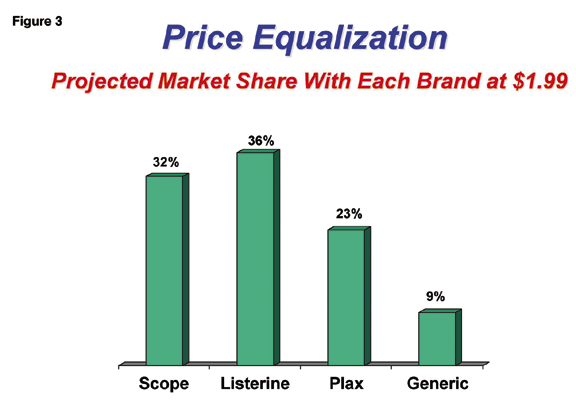 |
The results can be shown graphically (Figure 3). This is the projected market share if all four brands in the survey were priced at the same level, $1.99.
Of course, the model allows for immediate calculation of market share given different price levels. A common deliverable that our firm provides to its clients is a simulator, an Excel spreadsheet programmed to instantly calculate market share when the price goes up and down, or when a given brand is taken out of the equation by placing a 0 in the included column (Figure 4). The simulator is what is used to calculate brand equity.
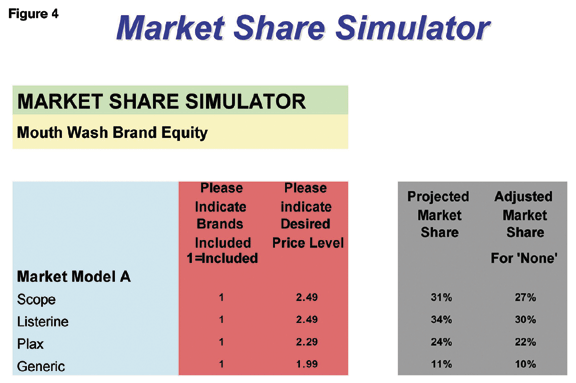 |
Fitting the model specifically to measure brand equity
Joffre Swait1 writes of equalization price (EP) as a measure of brand equity. He says that EP is made up of three contributing parts: 1) the market price for the brand; 2) the dollar value of the “objective” component of utility; and 3) the dollar value of the brand image. EP, he continues, can be calculated for an individual consumer (which can be mapped and used for equity segmentation). However, it is the aggregate dollar value of the brand image that interests us.
One way to look at EP is to calculate the market share given equal prices for all the mouthwash brands in the survey. Another is to measure at what point a brand has equal market share with the generic brand, the inclusion of which in the above example was for this purpose.
We have the simulator to accomplish this task. Let’s say we want to calculate Scope’s brand image dollar value. For this exercise, put a 0 next to Listerine and Plax so they are not included in the simulator’s calculation. Let’s say that the generic brand usually sells for $1.79. Set that price.
The next stage is to experiment with the Scope brand until it reaches an equal market share with the generic brand at $1.79. We start high, say $2.99, and work our way down. As shown in Figure 5, Scope accomplishes market parity with the generic brand at $2.59. Thus, according to our theory, we can say that Scope has a brand image worth $0.80.
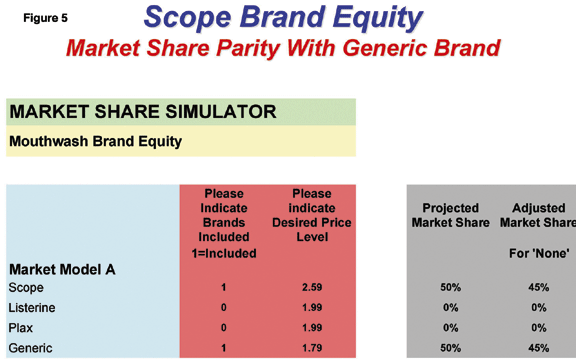 |
The power of this discrete choice model is that it also allows us to calculate brand image values for Listerine and Plax, inviting comparison. Also, once the heavy programming is done, it is a simple matter to “filter” the model by key groups. For example, perhaps the Scope people want to measure brand equity levels among men, women, young people (18-25), or by geographic area. The model can be run and a simulator can be constructed for each.
The utility of brand equity
There are many applications for the accurate measurement of brand image. It can be used to assess the extendibility of a brand name in its product category, to refine a brand’s communication efforts by identifying segments in which a brand’s image is strong, and/or as a way of monitoring the competition. Whatever its application, this method of brand equity measurement is a sophisticated tool that helps keep marketers one step ahead.
1 Swait, Tulin, Louviere, Dubelaar, (1993) “The Equalization of Price: A Measure of Consumer-Perceived Brand Equity,” International Journal of Research in Marketing, 10, 23-45).
